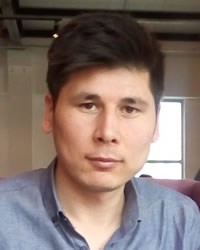Turkmen in Afghanistan

Photo Source:
Anonymous
|
Send Joshua Project a map of this people group.
|
| People Name: | Turkmen |
| Country: | Afghanistan |
| 10/40 Window: | Yes |
| Population: | 1,194,000 |
| World Population: | 8,709,600 |
| Primary Language: | Turkmen |
| Primary Religion: | Islam |
| Christian Adherents: | 0.00 % |
| Evangelicals: | 0.00 % |
| Scripture: | Complete Bible |
| Ministry Resources: | Yes |
| Jesus Film: | Yes |
| Audio Recordings: | Yes |
| People Cluster: | Turkmen |
| Affinity Bloc: | Turkic Peoples |
| Progress Level: |
|
Introduction / History
Turkmen groups migrated southward at various times in history from east of the Caspian Sea, settling along the rim of the Kara Kum (Black Sand) desert, which extends into Afghanistan. A Turkmen legend aptly describes this habitat. "When God created the world and distributed land, Turkmen were the first to receive abundant sunshine and the last to receive water." Once feared as the infamous "children of the desert", they lived as nomadic herdsmen/warriors whose fierce raids on caravans stole plunder and slaves to sell in regional markets. Today, a relatively small population of Turkmen is concentrated in a narrow region in north Afghanistan, extending along the border with Turkmenistan. Some continue a semi-nomadic life, while others live in permanent homes or tents, farming, raising livestock and weaving carpets. One can find Turkmen in most Central Asian countries, including Afghanistan. Typically, the Turkmen people in Afghanistan fled there between 1915 and 1940 from the Russian Empire and the Soviet Union.
Although the Turkmen are one of Central Asia's major people groups, they are a minority in Afghanistan, which is notable because they have formidable economic impact there. As a slight portion of the country's total population, their herdsmen supply world markets with prized Karakul sheep pelts and magnificent wool carpets from their renowned weavers. More than utilitarian or even an art form, carpet weaving is integral to Turkmen culture.
Cross-like designs may indicate a past history of Christian influence that left an indelible print and were preserved among time-honored symbols. Prior to the introduction of Sunni Islam by Arabs in the late 10th century, Nestorian Christianity had spread among Turkmen in the 4th century A.D. First called Turkmen in the 10th century as well, they are descended from Mongolian Oghug tribes that invaded today's Turkmenistan in the 8th century, where one tribe eventually established the fabled Ottoman Empire that lasted for seven centuries, and from which evolved both Turkmen language and customs. In the 19th century they forced by Russian expansion southward to begin uniting their separate tribes. They became the independent republic of Turkmenistan in 1991. Despite this, tribal identity, of which there are 7 major ones - Tekke, Ersary, Yomud, Gsklen, Salor and Chowdor - is still strong.
What Are Their Lives Like?
Wandering as tribal nomads for centuries, carpets laid on bare tent floors and used as tent flaps, blankets and trade items aided a family's survival in harsh climates. This skill allowed refugee Turkmen to weather recent years of war as weavers in neighboring countries like Afghanistan. An ancient art, the technique of pile weaving is thought to have originated with the Turkmen. Their world-famous, distinctive ruby-hued rugs are considered the best oriental carpets woven in Afghanistan and by refugees in Pakistan because most are still hand-loomed and colored with natural dyes. Traditionally a family enterprise, women used hand-spun wool from their flocks to create exquisite carpets on collapsible horizontal wood looms from memorized patterns that preserved tribal history.
As with most of the region's peoples, hospitality is a defining characteristic. It is said Turkmen serve tea and a meal, likely including vegetables, fruit, nuts and bread, before the purpose of a visit is stated. This "red carpet" treatment reflects a host's respect for his guest.
Traditional men's dress includes supple leather boots, belted tunics, voluminous long-sleeved coats and Persian lamb hats. Now, in more urban areas, this attire is replaced by neat suits, a crisp tie and polished shoes. Turkmen pride themselves as neat dressers. Women wear long, colorful, floral-patterned dresses over leggings and accessorize with a jewel-bedecked turban-like headdress and ample jewelry, particularly bracelets and anklets. Covering the face is not customary.
Turkmen family structure is patriarchal; thus, a father is accorded the highest respect by his eldest son next in line. Even so, historically, Turkmen have lacked powerful chieftains or political figures. Ideally, marriages are arranged so as to preserve appropriate tribal liaisons and are sealed by a bride price paid in cash or livestock. Interestingly, the bride's family compensates the groom's family with a small sum for raising him to manhood. Pregnancy is expected Immediately and failure to conceive can lead to divorce. Underlining the importance of children, names have specific meaning, often related to the day of birth, with a holiday birthday being especially auspicious.
What Are Their Beliefs?
Turkmen are Sunni Muslims of the Hanafi School, although the designation is largely one of cultural identification. Few know or practice its beliefs, intertwining them with old shamanistic holdovers that include curses, "evil-eye" charms and magic.
What Are Their Needs?
The Turkmen people need to be given the chance to hear the life-changing gospel so they can enjoy life to the full.
Prayer Points
Pray for loving gospel workers to catch a vision for reaching the Turkmens in Afghanistan for Jesus and that in God's sovereign timing the hearts of these people would be open and ready to follow him.
Pray for Jesus movements to bless extended families so the gospel will spread rapidly in Afghanistan.
Pray for the spiritual lives of the Turkmen people to become fruitful so others will be drawn to Jesus Christ.